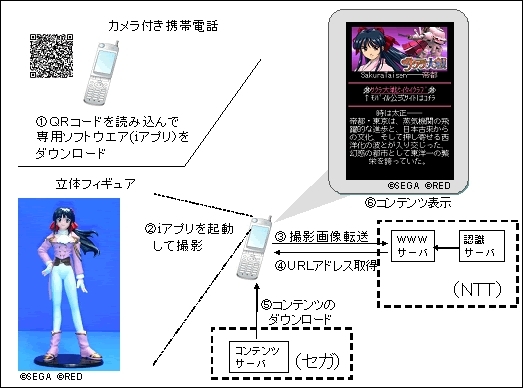NTT, Sega Testing 3D Technology
NTT and Sega Ltd. have started a joint experiment that utilizes object recognition technology developed by NTT Laboratory; the technology gives hyperlink functionality to patterns (trademarks, signboards, posters, etc.) as well as to solid things (commodities, etc.) that exist in the real world, and enables combination with various services on the Internet. The technology utilized in this experiment was developed by the NTT Cyber Communications Laboratory. NTT will conduct a verification of business applications through this joint experiment, while Sega will examine the development of new contents that use the technology.
This joint experiment can be experienced at NTT Group Communications EXPO held from December 20th to 22nd, 2005 (Tokyo International Forum) and at the OCN site by people at large. This event, where people at large can experience the service that combines a solid thing in the real world, which is recognized by the camera cell-phone, with the contents on the Net, will be the first one in the world.

1. Purpose of the experiment
Before this experiment, the NTT Cyber Communications Laboratory and Sega – implemented a preliminary experiment at the Super Song Show “New Blue Bird” (executed from August 13th – August 20th of 2005), whose theme was “Sakura Taisen” (game’s title), based on the printed materials like handbills distributed to the visitors, posters in the halls, etc., and its technological characteristics were verified. This time we will take pictures of 3D figures, etc., so that we can check if the technology enables us to add the hyperlink function to the solid things even without giving them IDs, bar codes, frames, etc., and accordingly the effectiveness and the practicality of the technology will be evaluated.2. Outline of the experiment, etc.
We will offer a service in which a user can access to a site dedicated to the cellular phone, such as the sites of “Sakura Taisen Keitaiclub”, “Sonic Cafe”, “Mushiking.com”, etc., by taking a picture of Sega’s solid figures, such as “Sakura Taisen”, “Sonic the hedgehog”, and “Mushiking – The King of Beetles”, or a picture of a plane image displayed on a monitor screen of a Web site for a personal computer.Points of the technology used
– The pre-processing of an object to be recognized is unnecessary.
– A solid thing can be recognized.
– The recognition level is less susceptible to the photograph environment (high tolerance to a change in the lighting, complicated background, and concealment.)
The Object Recognition Technology is a technology, which statistically studies how an object is seen from all the directions, registers the feature of the data in the object dictionary, compares an image data of the photographed object with the data in the dictionary while its clipping size and position are changed, and recognizes the targeted object. We have been developing this technology for practical use, which is less susceptible to the photograph environment, e.g., quick response to a change in the lighting, partial concealment of an object, dealing with the complicated background, etc., by making an improvement in the extraction of the characteristic data and the study method.
As for the technology that gives the hyperlink function to an object in the real world, there are coding technologies like plane bar codes, electronic watermark technology to imprint data on printed material, etc., or image recognition technology to deal with plane objects, etc., but they have some restrictions, e.g., it is necessary to print the frame beforehand that provides for a code pattern or a range of a photograph. In contrast, this object recognition technology doesn’t need to process an object itself beforehand, and has a big merit that it can transact even a solid thing.
3. Specific scenes where the technology is used
This technology, which easily gives the hyperlink function to an object in the real world and realizes the combination between the object and the services on the Net, can be used in a wide range of fields. Various 2D/3D objects existing in the living space will become the entrance toward the abundant services on the Net, e.g., a contents offering service that gives an additional value to a solid figure as explained in this experiment, a sales promotion service where a premium can be gotten when a picture of the commodity package is taken and applied for, an information offering service where you can obtain the information on a company when you take a picture of its brand mark on the street, etc. (See attached Appendix 3)4. Development in the future
This joint experiment is a project that utilizes the Integrated Production Function (Note 2), in which NTT’s research results will be put into a business operation based on cooperation with the enterprises inside and outside of the NTT Group. NTT will promote the full-scale development of the business that will use this object recognition technology as well as the related electronic watermark technology for still/moving pictures while positioning these technologies as a tool to realize the various services in all the places by connecting objects like printed matters, shaped articles, etc. in the real world with the information and the services on the network. In addition, Sega will examine new contents development that makes the best use of these technologies.
